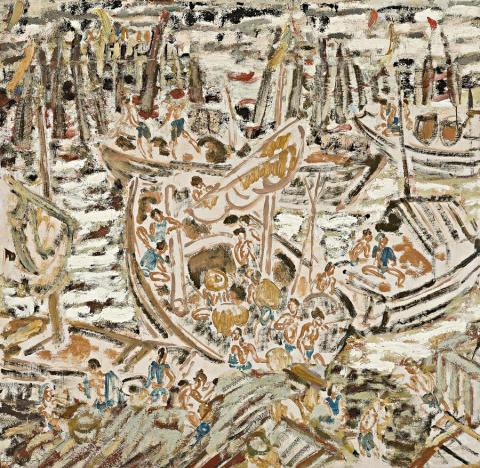BOATS AT SOOCHOW CREEK, 1938
IAN FAIRWEATHER
oil and pencil on paper on cardboard
110.0 x 112.5 cm
signed lower left: I Fairweather
Collection of Lina Bryans, Melbourne
Thence by descent
Private collection, Melbourne
Fairweather: a Retrospective Exhibition, Queensland Art Gallery, Brisbane, 3 June – 4 July 1965; Art Gallery of New South Wales, Sydney,21 July – 22 August 1965; National Gallery of Victoria, Melbourne, 9 September – 10 October 1965; National Gallery of South Australia, Adelaide, 26 October – 21 November 1965; Western Australian Art Gallery, Perth, 9 December 1965 – 16 January 1966; Tasmanian Museum and Art Gallery, Hobart, 10 February – 13 March 1966, cat. 68 (label attached verso)
Fairweather, Queensland Art Gallery, Brisbane, 1 October – 27 November 1994; National Gallery of Victoria, Melbourne,17 December 1994 – 19 February 1995; Art Gallery of New South Wales, Sydney, 22 March – 7 May 1995, cat. 9 (label attached verso)
Thomas, L., 'The hand of a master', Bulletin, 4 December 1965, p. 41 (illus.)
Bail, M. et. al., Fairweather, an Art and Australia book, Craftsman House, Sydney, in association with Queensland Art Gallery, Brisbane, 1994, pp. 64, 69, 81, pl. 9 (illus.)
Bail, M., Fairweather, Murdoch Books, Sydney, revised edition 2009, pp. 18, 53,55–56, 218, 237, 247, cat. 39, pl. 32 (illus.)
Forwood, G., Lina Bryans: Rare Modern 1909–2000, Melbourne University Press Melbourne, 2003, pp. 89, 91 (illus.)
Ian Fairweather arrived in Shanghai in about May 1929, settling in the former American concession on the spacious top floor of a building at 235 Szechuen Road. His biographer Murray Bail tells us that 'His window overlooked Soochow Creek: a hectic pattern of sampanson straw-coloured water which remained in his memory. Nine years later in the Philippines, he completed Boats at Soochow Creek - a painting of life and light and commerce.'1 In July 1938, Fairweather sent the painting to his fellow artist Jock Frater in Melbourne, describing it as 'like the view from my window on Soochow Creek (Shanghai)'.2 Emphasis must be placed on the word 'like', for to describe it as a 'view' or a landscape would be telling only part of what this beautiful painting is about. It is all this and more.
In Boats at Soochow Creek Fairweather brings together abstraction and figuration as effortlessly as he does the styles of East and West. A perfect balance is achieved between these diverse ways, continued in the complete harmony of line and colour, as colour frees itself from form. The sparkling chaos on the creek is brought together with calligraphic rhythm and painterlybravura.3 Fairweather holds the bustle of people, boats, light on the waters, in classic stillness. It is but another fascinating example of the paradoxical at work in his art, as in the narrative of the non-narrative, and the many being one. Again, there is that ambiguity of space as the artist avoids a focal point for overall appeal, creating a two-dimensional effect as often seen in a tapestry or mural. Ideas, technique and medium are one as Fairweather's enlightenment touches the universal.
Out of the many treasures in Fairweather's retrospective exhibition of 1965, Laurie Thomas, writing in the Bulletin, selected Boats at Soochow Creek, 1938 out for special comment. 'Perhaps the key to much of the later work lies in such a painting as 'Boats at Soochow Creek' where the drawing, though evident, is complemented by a variegated pattern of broken shapes. It seems to me that this picture brings together the previous tendencies of Fairweather's work and holds the seeds of a great deal of its later development. The tendency here is to re-state a landscape and to make a work of art in such a way that nothing is seen or visualised as more important then anything else. Trees, boats, water, figures, are all one thing, all part of the choppy light which breaks off the water and suffuses the whole in a quiet dazzle.'4
Soochow Creek (nowadays Suzhou) flows through the centre of Shanghai, long an important commercial hub. The creek, really a river, grew into an important shipping route in and out of central China during the 1930s. Life on the rivers, the great water highways of China, fascinated Fairweather, life as diverse as in Fish Traps, Peking, 1935 (Art Gallery of New South Wales), the lyrical Bridge, Hangchow, 1941 (National Gallery of Victoria, Melbourne), and River, Hangchow, 1941 (National Gallery of Australia, Canberra). Boats at Soochow Creek, 1938 is one of the best.
1. Bail, M., Fairweather, Murdoch Books, Sydney, revised edition 2009, p.18
2. Ibid, p. 247
3. In his catalogue entry on this painting, Murray Bail, noted that 'Some pencil marks have been rubbed out a little during restoration work in 1966', ibid
4. Thomas, L., 'The hand of a master', Bulletin, 4 December 1965, p. 38
DAVID THOMAS
